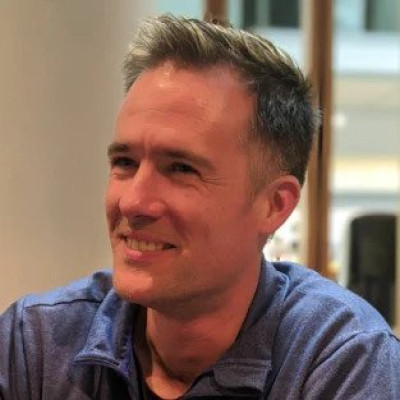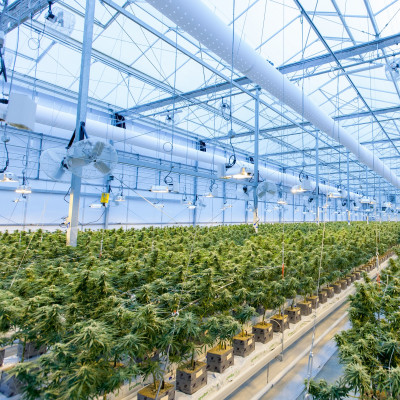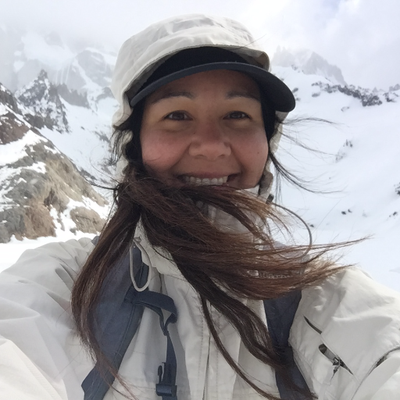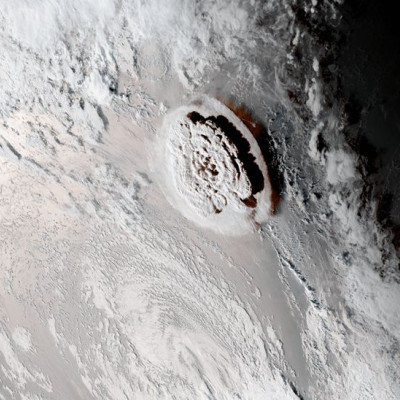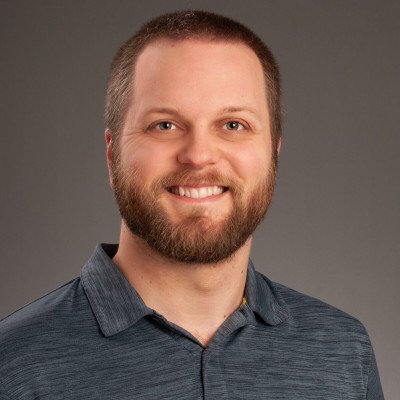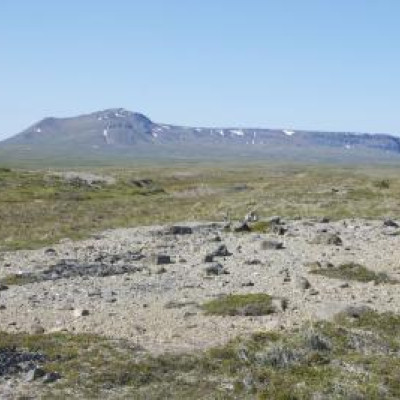News
Stay up-to-date with what's happening in EOAS
Meet Dr. Christian Schoof - Glaciologist
Christian earned his MPhys in Physics in 1998, his DPhil in Mathematics, 2002, and did a post-doctoral degree at UBC from 2002-2007. He’s been a teaching faculty member of UBC in glaciology since 2007. He specializes in understanding the physics of how a glacier moves, and is passionate about the outdoors.
Reviewing air quality impacts of cannabis cultivation facilities
Davi Monticelli, Naomi Zimmerman
With the legalization of cannabis for medicinal and recreational purposes in many districts around the globe, the cannabis industry is expected to expand. This expansion implies in an increase of the number of facilities and their size. In countries like Canada, for instance, since approval of cannabis at a federal level, there was an 8-fold increase in legal cannabis stores. However, the environmental impacts of cannabis cultivation are not fully understood, and the time to address them is now, before industry practices become fixed and regulations or mitigation strategies become difficult to implement.
One area of particular emphasis is impacts on air quality. Davi de Ferreyro Monticelli, a PhD student in Atmospheric Sciences at EOAS, led a new study to address knowledge gaps in cannabis cultivation facility (CCF) from emissions to health impacts, encompassing the full scope of an air quality assessment.
We knew beforehand that cannabis cultivation was associated with the emission of biogenic volatile organic compounds (BVOCs) and odour. Thus, the initial studies reviewed addressed (“cannabis” or “cannabis cultivation”) and (“voc” or “odour”). Further on, the research developed into 1) indoor or outdoor cultivation emissions, 2) monitoring or modeling of cannabis air quality impacts, 3) health effects at the occupational or community level, and 4) life cycle assessment of cannabis cultivation.
The main result of the critical review was to pinpoint our knowledge on this industry atmospheric emissions, and why and how to mitigate them. "The most surprising fact for me was how much variation in BVOC content one can find by measuring the air quality indoors and outdoors of cannabis cultivation facilities,” says Davi. For this and other reasons, emission inventories are still at the early stages of development. In Metro Vancouver, the emission estimations range from 15 tVOC.y-1 to 2083 tVOC.y-1depending on the use of lowest or highest values for all input variables such as emission factor, estimated growing area and time. Industry, academia, and regulators should work in parallel to reduce such uncertainty.
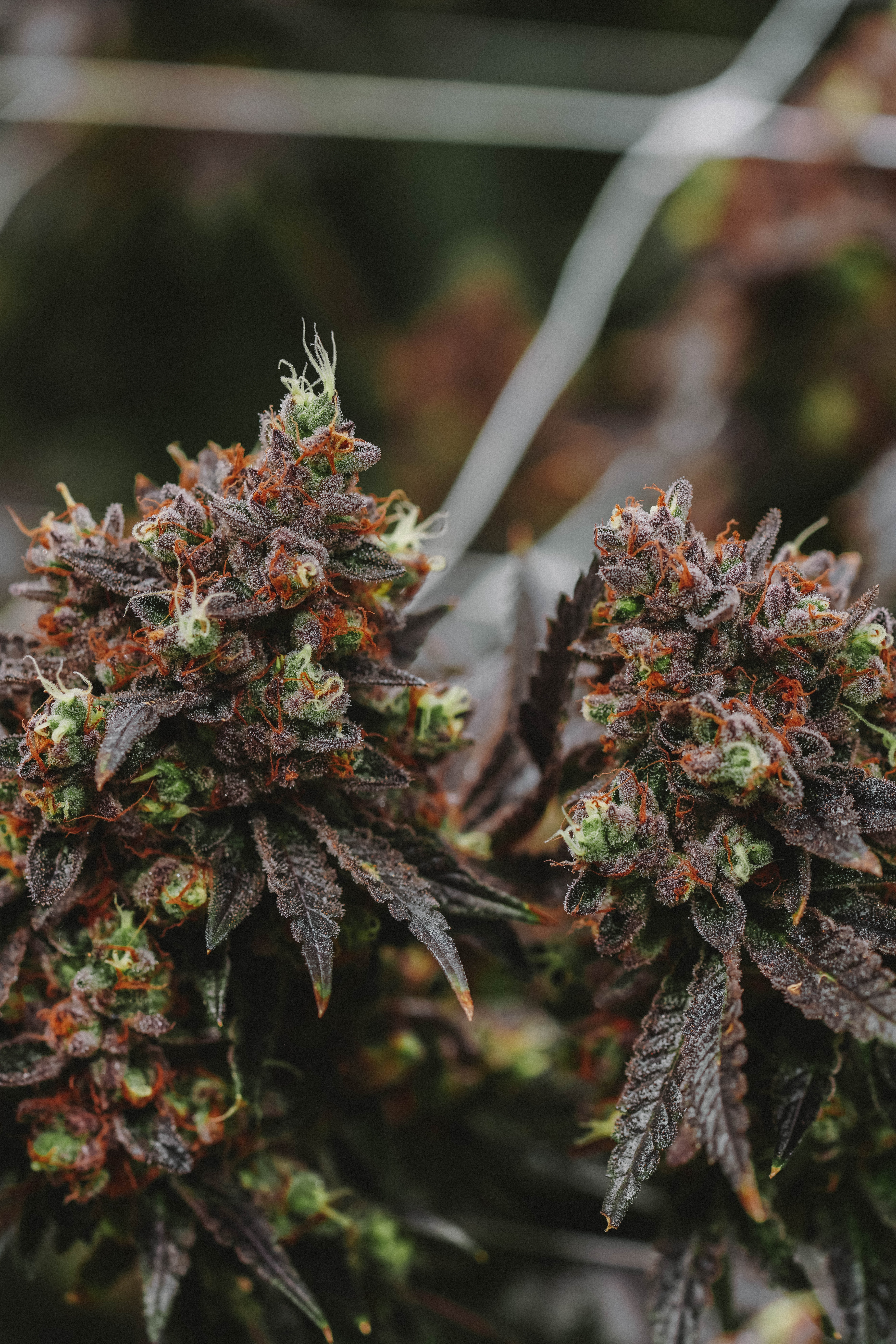
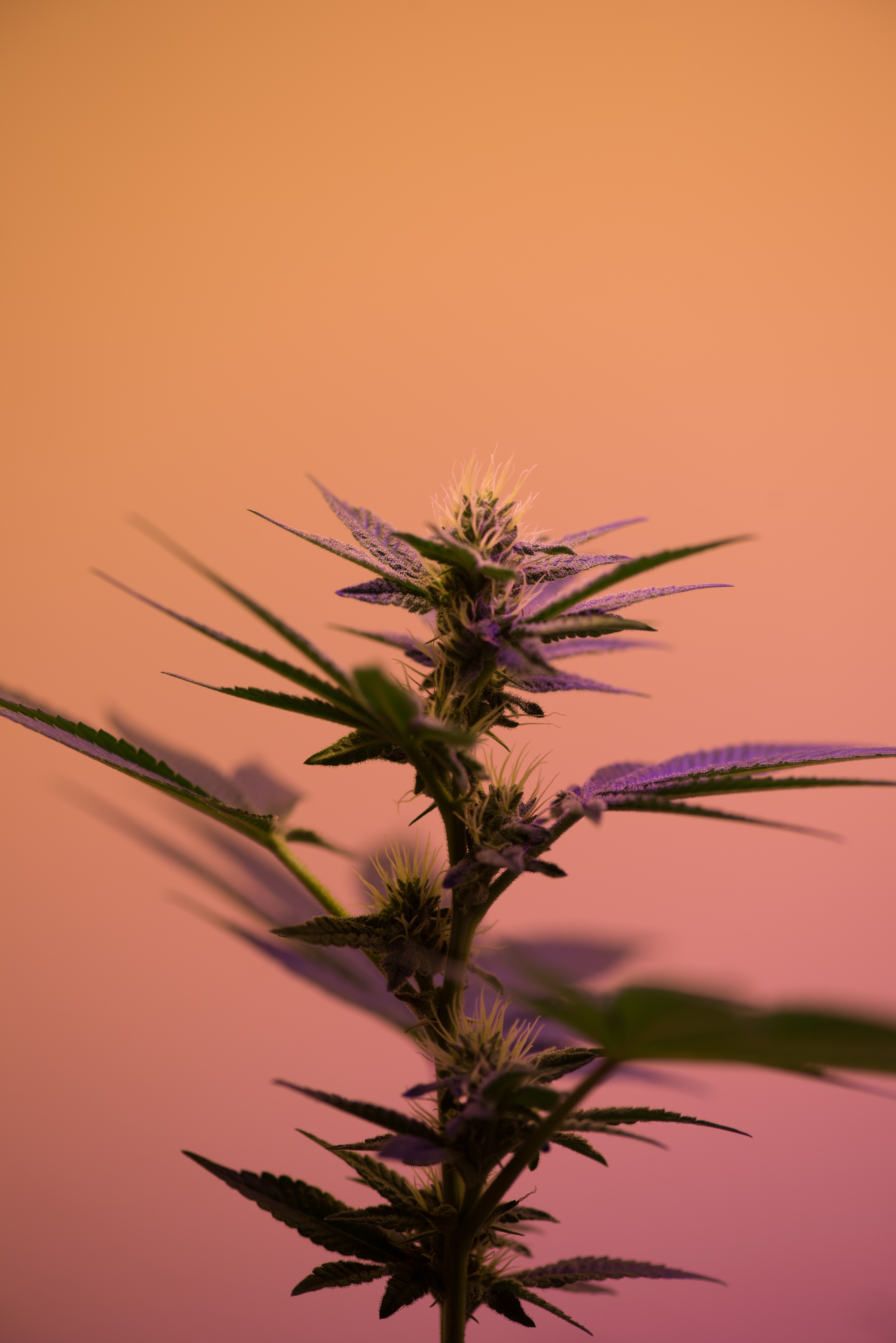
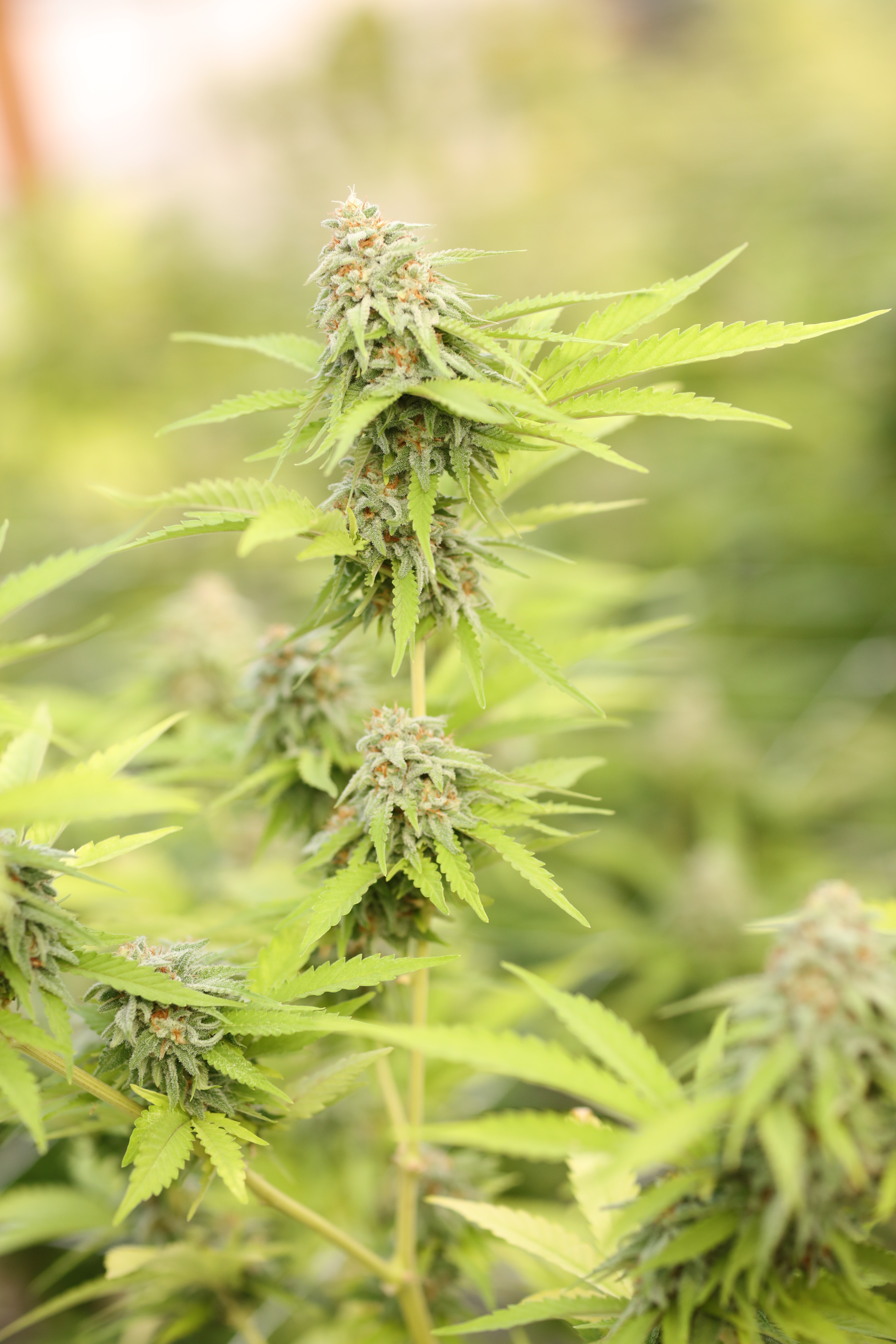
Different strains of cannabis plants (Credit: Unsplash)
Another aspect of emissions is odour. Studies indicate that cannabis odorous emissions can be traced to terpenes and volatile sulfurous compounds (VSCs). Between them, terpenes received more attention in the literature, but recent studies suggest that VSCs could have equal to higher contribution to cannabis aroma. When comparing the odor concentration emitted by livestock operations, we estimated that a facility that cultivates 1700 plants has an odour contribution (800 OU.s-1) similar to a livestock operation of 30 pigs or 1600 poultry. Interestingly, one facility with equal capacity and emissions controls (1700 plants) reduced their emissions by about 75% (200 OU.s-1).
“What I like the most about the project is the opportunity of conducting research that addresses some of the gaps we found in the literature and thus advance our knowledge about this industry at a time where changes can be highly impactful,” says Davi. He and his co-authors identified 16 opportunities to be explored by the industry, regulators, and academics. Those include improving emission inventories and understanding of the photochemical mechanisms by which emitted compounds go through once in the atmosphere. These gaps provide a way forward in terms of monitoring and modelling the impacts of emissions from cannabis cultivation facilities. In this sense, our review can be used by stakeholders to design air quality assessment studies and set priorities.
Learn more about the study on UBC News: https://news.ubc.ca/2022/02/15/investigating-the-skunk-smell-and-other-emissions-caused-by-cannabis-production/
Check out other media coverage: https://acs.altmetric.com/details/122788293/news
To read the critical review: https://pubs.acs.org/doi/10.1021/acs.est.1c06372
How do carbon and water fluxes change with land use and land cover? - Brenda D'Acunha
How do carbon and water fluxes change with land use and land cover in the Amazon, Cerrado and Pantanal biomes? Watch our interview with EOAS Geology PhD Candidate Brenda D'Acunha about her research talk at AGU21 to find the answer!
EOAS Volcanologists Study the Eruption of Hunga Tonga-Hunga Ha'apai Volcano that Rocked the World
The people of Tonga are recovering from an extremely violent and explosive eruption of the Hunga Tonga-Hunga Ha’apai volcano located 65 km to the North of Nuku’alofa, the capital of the Tongan islands. Hunga Tonga-Hunga Ha’apai volcano erupted at 04:20 Tonga Standard Time on January 14, 2022 and produced a 20 km high eruption column. Then at 17:00 TST on January 15, 2022 the volcano violently exploded with a bang so loud that it rocked the ears of people on the island of Fiji some 700 km away and was heard as far away as Alaska, roughly 10,000 km away. Satellite instruments were able to track the shock wave as it travelled through the atmosphere to the opposite side of Earth in less than a day and continued to circumnavigate the Earth thereafter. The eruption generated tsunamis that devastated the islands of Tonga and travelled around the world, including in the Atlantic ocean where some researchers think the shock wave travelling along the ocean surface generated the tsunamis, which would be the first time such a natural phenomenon was observed with modern instrumentation.
The eruption of Hunga Tonga-Hunga Ha-apai is of pressing interest to EOAS volcanologists Colin Rowell, Johan Gilchrist and Mark Jellinek, not only because of its global effects, but because of the surprisingly violent character of the eruption, and – critically – that it was captured by a suite of modern satellite instruments (Figure 1).
To understand the distinct nature of the eruption, it helps to understand what can happen when erupting magma (at temperatures of around 1000 °C) comes into contact with much colder surface waters. When this happens, the resulting thermal shock sometimes causes the magma to fracture violently, exposing more of the magma’s fresh, hot interior. This can result in a chain reaction, tearing the magma apart into tiny pieces, exposing fresh magma surface, and delivering an incredible amount of heat energy to the water in mere thousands of a second. With enough magma and water involved, the result is a steam explosion with a power rivaling nuclear bombs. This process is a likely cause of the powerful shockwaves that emanated from the eruption on January 15th. The power of the large blast that circled the globe has been estimated at 10 megatons of TNT equivalent, more than 500 times the bomb dropped on Hiroshima, with some estimates rising as high as 50 megatons or more. This event may well have been primed by the eruptions of the day before, which destroyed much of the existing island that was above sea level (Figure 2), deepening the vent to tens of meters or more under the waves and possibly allowing sea water to more readily access the plumbing system. More water does not necessarily mean a more explosive eruption, however: if the volcanic vent had opened at even greater depths, the overlying water pressure would have dampened the resulting steam explosion, limiting its power and by connection, the record-breaking heights reached by the eruption column.
This is where modern satellite imagery comes into play, unprecedented in its clarity and resolution. Johan is using the high-quality photos that span the entire eruption to calculate heights of eruption clouds and how they spread across the atmosphere, key pieces of information when it comes to trying to predict how a volcanic eruption will affect the climate. “When eruption columns rise above the troposphere, us volcanologists immediately try to analyze the data to determine the potential for a volcano-climate effect,” says Johan Gilchrist. The troposphere is the lower layer of the atmosphere where weather happens and airliners fly, and typically stops at around 16 kilometers above sea level in the tropical areas of the world. Eruption clouds that rise higher than the troposphere, into a layer called the stratosphere, can stay circulating up there for months or years. That’s where climate-altering sulfur compounds like sulfur dioxide (SO2) can have the biggest effects. “This eruption column not only breached the troposphere, it continued to rise through to the upper limits of the stratosphere near the mesosphere” exclaims Johan. “Mark didn’t believe me when I told him I had measured a 55 km altitude for the highest visible cloud, and shoot, I didn’t believe my analysis either until another independent researcher also reported the same number.”
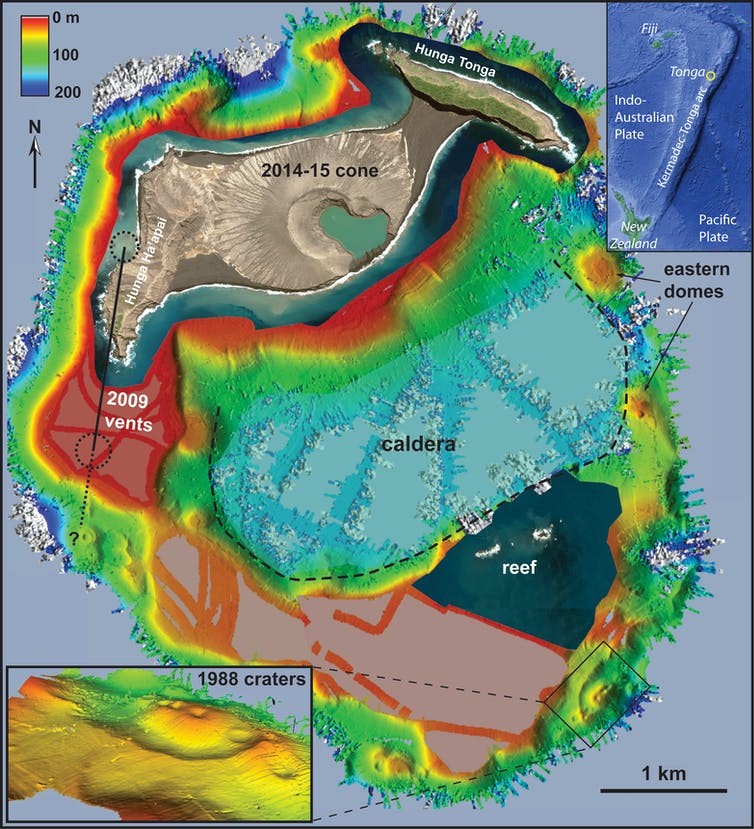
Figure 2: Bathymetry data showing the depth of the Hunga Tonga-Hunga Ha’apai caldera with a satellite image of the 2015-2022 location of its most recent eruptions. From Cronin (2022).
Despite its height, the eruption column has an unusually low amount of sulfur, which may be a characteristic of this type of steam-driven eruption according to a recent study of Colin’s, currently in peer-review. The study hypothesizes that water-rich eruptions should have weaker climate impacts than those driven by magma alone. “In my study, that’s a result of the added water changing both the heat available to the eruption as well as a change in the cloud chemistry, with higher amounts of water and fine particles being present in the cloud. Whether that’s exactly what is happening here, though, remains to be seen!”
Johan, Colin and Mark will continue to refine their analysis of the eruption in the coming weeks. Johan’s satellite-imagery analysis will provide parameters, such as column height and spreading rate, that Colin can input into new model simulations of the eruption. If the model is a test for how eruptions work in the real world, data from the real eruption acts as an answer key. If the model has the same outcomes as the real-world eruption, for example reproducing the observed eruption column top and umbrella cloud spreading heights, that gives researchers confidence to use the model as a tool to explore eruption processes in greater detail. Johan, Colin and Mark plan to use their model to gain more understanding of the properties of the eruption column as it rose through the atmosphere and, hopefully, come up with an estimate of the amount of ash and gases that were delivered to spreading clouds higher in the stratosphere. This estimate can be used, in turn, to run ash transport models that are used to set no-fly zones for airliners and in global climate models to assess potential impacts on Earth’s climate.
The research group’s future work aims to conduct analog experiments using materials like water and sand meant to mimic eruptions on a much smaller scale. These experiments allow the researchers to learn more about the physical processes that determine how erupted mass is transported in the eruption column, which ultimately determines where clouds spread in the atmosphere and how much ash and gas they carry. Insights from these experiments can be used to calibrate Colin’s computer models, to explore different climate impact scenarios between water-rich eruptions versus those driven by magma alone.
Being able to validate a model with real-world data is crucial, and is why eruptions like Hunga Tonga-Hunga Ha’apai are so critical to observe in great detail. The people of Tonga are suffering from this event, but the global community at large won’t have to deal with the potentially serious climate consequences that such an event can bring. It is essential that scientists learn about Hunga Tonga-Hunga Ha’apai’s eruption history, this latest eruption event and what types of eruptions could be in store for the future. That knowledge is used to help local communities, such as Tongans, prepare for and respond to these catastrophic events, and to help global society prepare for the climate-hardship that future volcanic events could cause.
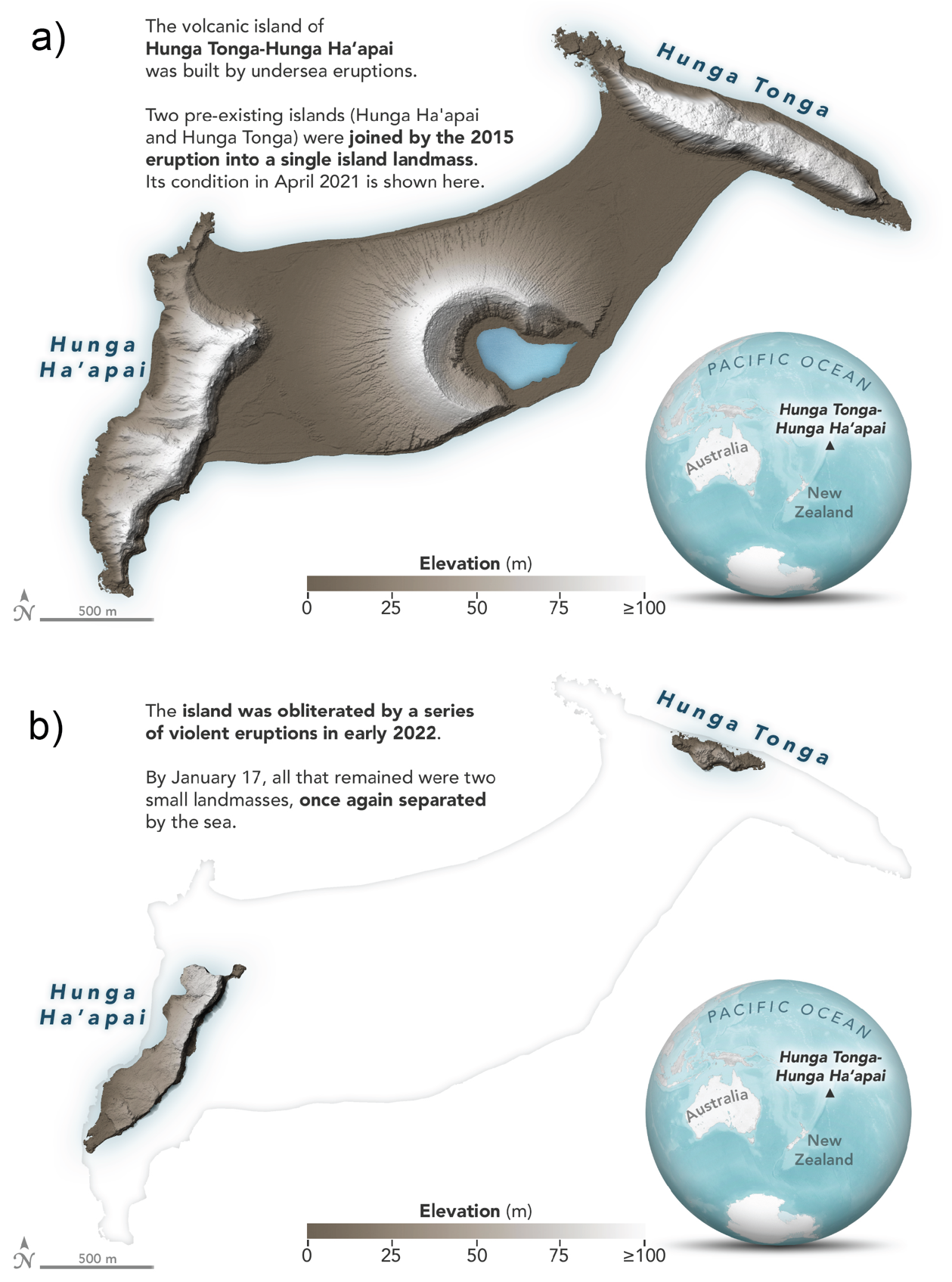
Figure 3: Digital elevation models of the Hunga Tonga islands before (a) and after (b) the Jan 14-15 eruptions. Courtesy of NASA.
Meet Dr. Corey Wall - Geochronologist
Corey Wall is the Facilities Manager and U-Pb geochronologist for the Pacific Centre for Isotopic and Geochemical Research, at the Department of Earth, Ocean and Atmospheric Sciences at the University of British Columbia. He is interested in determining the age of rocks using minerals that can be extracted from them. He aims to extract minerals such as zircon and determine the age of the rock by precisely measuring the elements Uranium and Pb on mass spectrometers. Before joining EOAS, Corey was a post-doctoral researcher and a research scientist at the Isotope Geology Laboratory at Boise State University, Idaho. Corey provides analytical services to faculty member, government geological surveys, and private sector exploration and mining companies.
Englacial lake dynamics within a Pleistocene Cordilleran ice sheet at Kima' Kho tuya (British Columbia, Canada)
Kelly Russell, Benjamin Edwards, Marie Turnbull and Lucy Porritt
Kima' Kho tuya is a Pleistocene (1949 ± 63 ka) (ka: kilo annum; one thousand years) glaciovolcano in the northern Cordillera of British Columbia. In a new EOAS research published in Quaternary Science Reviews, Professor Kelly Russell and his co-authors, Benjamin Edwards (Dickinson College), Marie Turnbull and Lucy Porritt, reconstructed the englacial lake dynamics attending the volcanic evolution and growth of Kima' Kho volcano, including a massive, catastrophic deluge.
Volcanic eruptions, when interacting with the cryosphere (i.e., snow, ice, firn, permafrost, and meltwater), produce edifice morphologies and deposit lithofacies that directly reflect their eruption environment. These glaciovolcanoes represent a proxy for local and global paleoclimates and they are the only evidence of ancient ice masses coinciding with the time and location of the eruption in many cases.
“Passage zones” are stratigraphic surfaces found in littoral settings separating volcanic deposits diagnostic of subaqueous environments from overlying sequences of subaerial deposits. In glaciovolcanic settings, these surfaces are important because they unequivocally record the heights and depths of sustained within-ice lakes of meltwater (i.e. syn-eruptive englacial lakes), thereby informing on the presence and nature of the enclosing ice sheet.
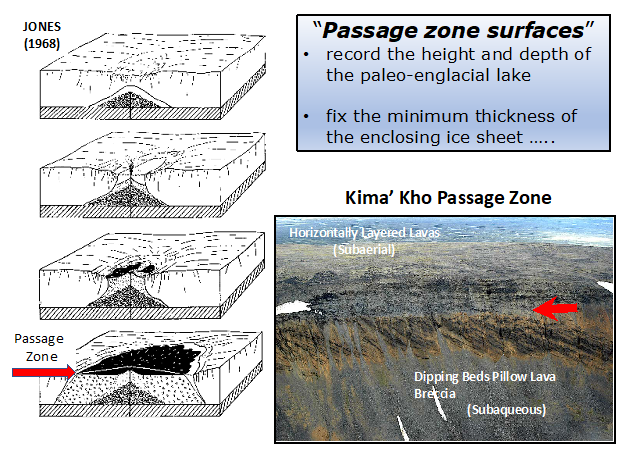
Definition of the term “passage zone”. Cartoon from Jones (1968) shows the formation of passage zones in glaciovolcanic environment and field photograph shows one of the passage zones preserved at Kima’ Kho where lavas erupted into a dry environment have flowed over and capped contemporaneous pillow-lava breccia beds that are deposited in a deep englacial lake of meltwater.
Kima' Kho is unique as it is one of only a few well-documented tuyas that hosts multiple and diverse passage zones. Three temporally distinct passage zones record the interplay between growth of the volcanic edifice, syn-volcanic melting of the enclosing ice sheet, and fluctuations in the depth of the englacial lake. The earliest passage zone (PZ1) was formed during the initial explosive phase of eruption when the tephra cone became emergent from the 340 m deep englacial lake. Two subsequent passage zones (PZ2-3) occur at lower elevations, indicating a major draining of the englacial lake followed by refilling to depths of 230-180 m and 260-280 m, respectively. The substantial decline in lake level between PZ1 and PZ2 suggests a massive, catastrophic deluge (i.e. jökulhlaup) of 1-2 km3. Lastly, the reconstructed glaciovolcanic evolution of Kima' Kho demands the presence of a regionally extensive ice sheet overlying the Kawdy plateau at ~1.9 Ma and representing an earlier incarnation of the Cordilleran Ice Sheet (CIS).
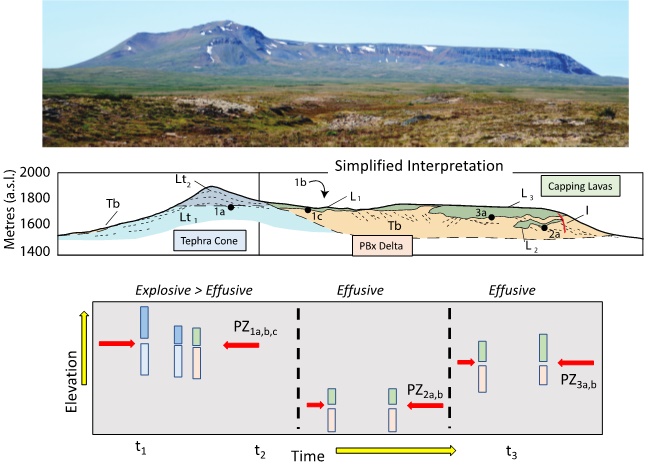
Passage zones preserved in Kima' Kho edifice. Top panel: Field photograph of Kima' Kho tuya looking to the west. Middle panel: Corresponding geological cross-section showing projected distribution of the main volcanic lithofacies (Lt1/Lt2: subaqueously and subaerially deposited lapilli tuffs representing an explosive onset to the eruption. Tb1-3: subaqueously deposited and steeply inclined beds of tuff breccia dominated by pillow lava fragments. L1-3: stacked sheets of subaerial pahoehoe lavas) defining several passage zones (1-3). Bottom panel: Stratigraphic logs showing lithofacies variations used to define three separate passage zones (PZ: 1-3) and their elevations.
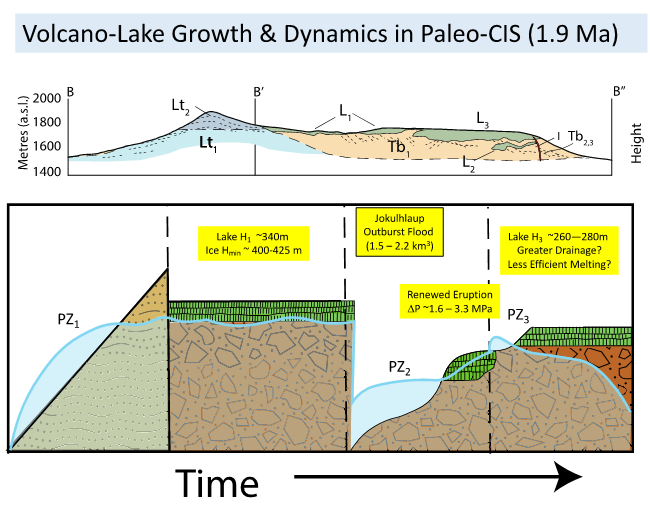
Conceptual summary model for the temporal evolution of Kima' Kho volcano and associated englacial lake.
